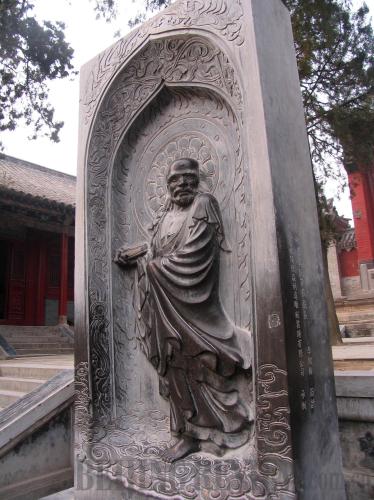|
 |
|
SACRED IMAGE: A carving on a stele in the Shaolin Temple shows the image of Daruma, father of Zen Buddhism in China (CFP) |
The 1,400-year-old pagoda in the Songyue Temple, the architectural complex of the well-known Shaolin Temple and the Huishan Temple tell of the influence of Buddhism in different periods in China, which has also had a significant and long-time effect on architectural styles in surrounding areas.
At 45 meters high, the pagoda in the Songyue Temple is the oldest brick pagoda in China and also the only dodecagon pagoda with eaves in the country.
The Shaolin Temple was included in the world heritage site because of its Buddhist architecture—not the stunning Shaolin kungfu which originated in the temple and made the temple famous around the world.
Three sites in the temple are listed, including the Pagoda Forest, an area of pagoda tombs of eminent monks at the temple; the Chuzu Hut (Progenitor Hut), a cluster of small ancient buildings built in the Song Dynasty to commemorate Daruma, father of Zen Buddhism in China; and the Changzhu Yard, the central area of the temple where monks live and attend religious activities.
Covering an area of around 20,000 square meters, the Pagoda Forest comprises more than 250 pagodas of various sizes and heights, making it the largest pagoda aggregation in the country. No higher than 15 meters, normally one to seven stories, these pagodas are constructed from brick or stone, or a mix of the two.
The carvings and inscriptions on the pagodas tell people the exact year each pagoda was built and other relevant information. As these pagodas were built in different dynasties, their site has become one of the main places to study the architecture, calligraphy and carving art of ancient China.
The historical constructions, stone carvings and frescoes in the Shaolin Temple fully present the history of Zen Buddhism's development in China, as well as the history and meaning of Shaolin kungfu, two major components of Shaolin culture.
The well-preserved Songyang Academy, built in the Northern Wei Dynasty, is the earliest school in China to spread Confucian doctrines, serving as a center for the worship of Confucian sages and the holding of examinations.
The Observatory of Stars, built by Guo Shoujing (1231-1316), a renowned astronomer and mathematician in Yuan Dynasty, is the oldest astronomical observatory in China, and is also the oldest architecture in the world used to observe celestial phenomena. The local government dismantled industrial facilities nearby and has restored the open and quiet scene to allow observation.
Traditional concepts
These ancient architectural collections, named "Center of Heaven and Earth," fully embody China's traditional concepts of the universe, which hold China was located in the middle between Heaven and Earth, while the center of Heaven and Earth was in central China. As the heart of central China was today's Dengfeng, the region gradually became the site for emperors of many dynasties to build their capitals, meaning to show their status had been granted by deities.
The mainstream philosophical schools in China—Confucianism, Taoism and Buddhism—have made the region a center to spread their teachings.
The clusters of ancient buildings in Dengfeng collectively represent ancient concepts of the universe, which had a huge influence on fields such as architecture, art, religion and science in ancient China, said Tong Mingkang, Deputy Director of the State Administration of Cultural Heritage.
"This year, China better conveyed its traditional concepts of the universe to the world heritage committee, as well as the interaction between ancient astronomy and the supremacy of the imperial dynasties and the comprehensive influence of these ideas on the architecture, religion and art in the region," Tong said.
| 